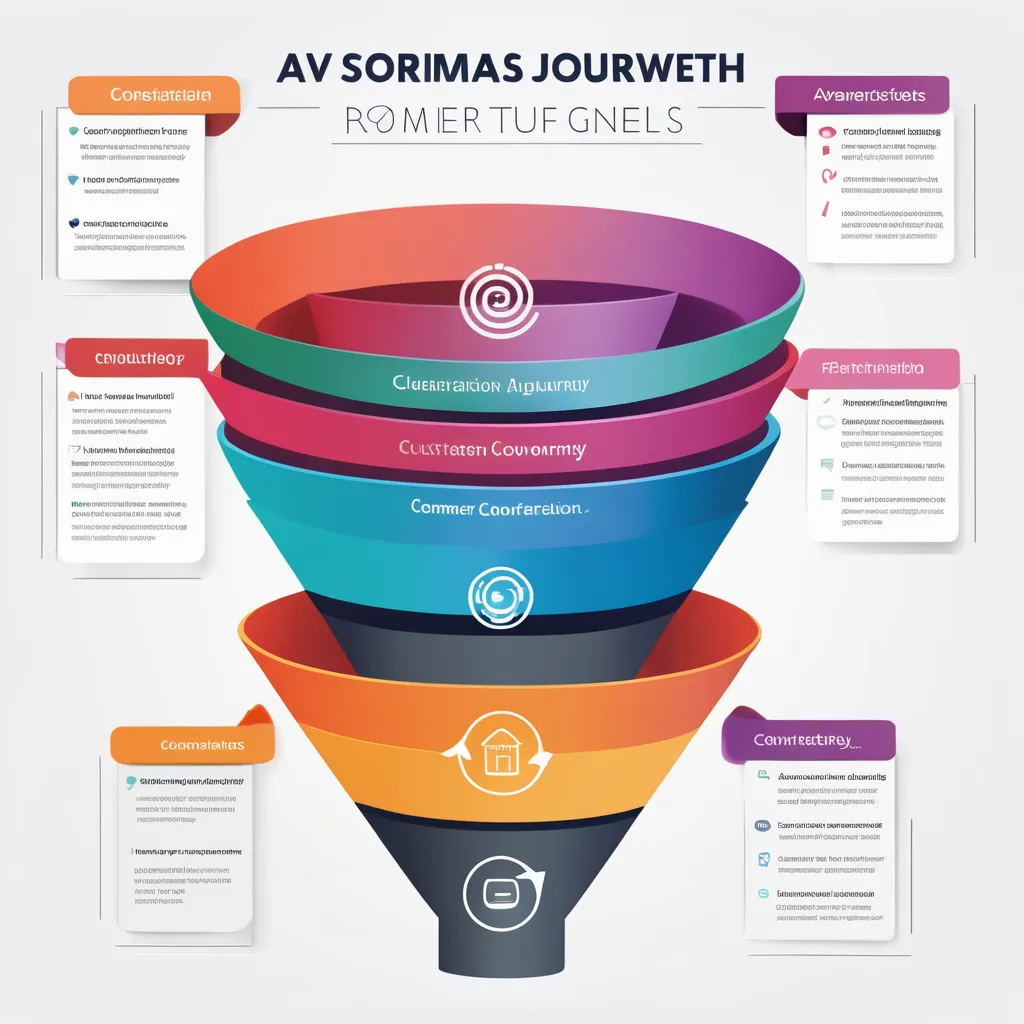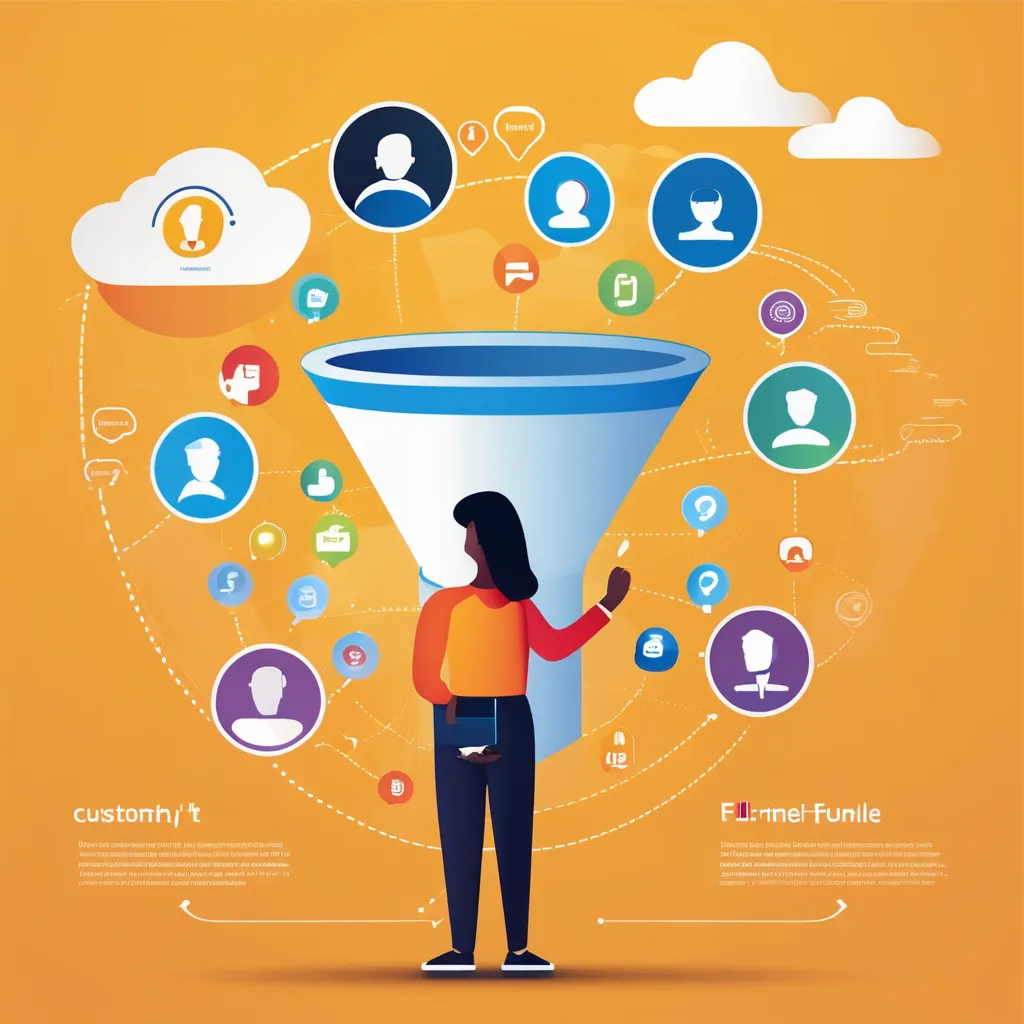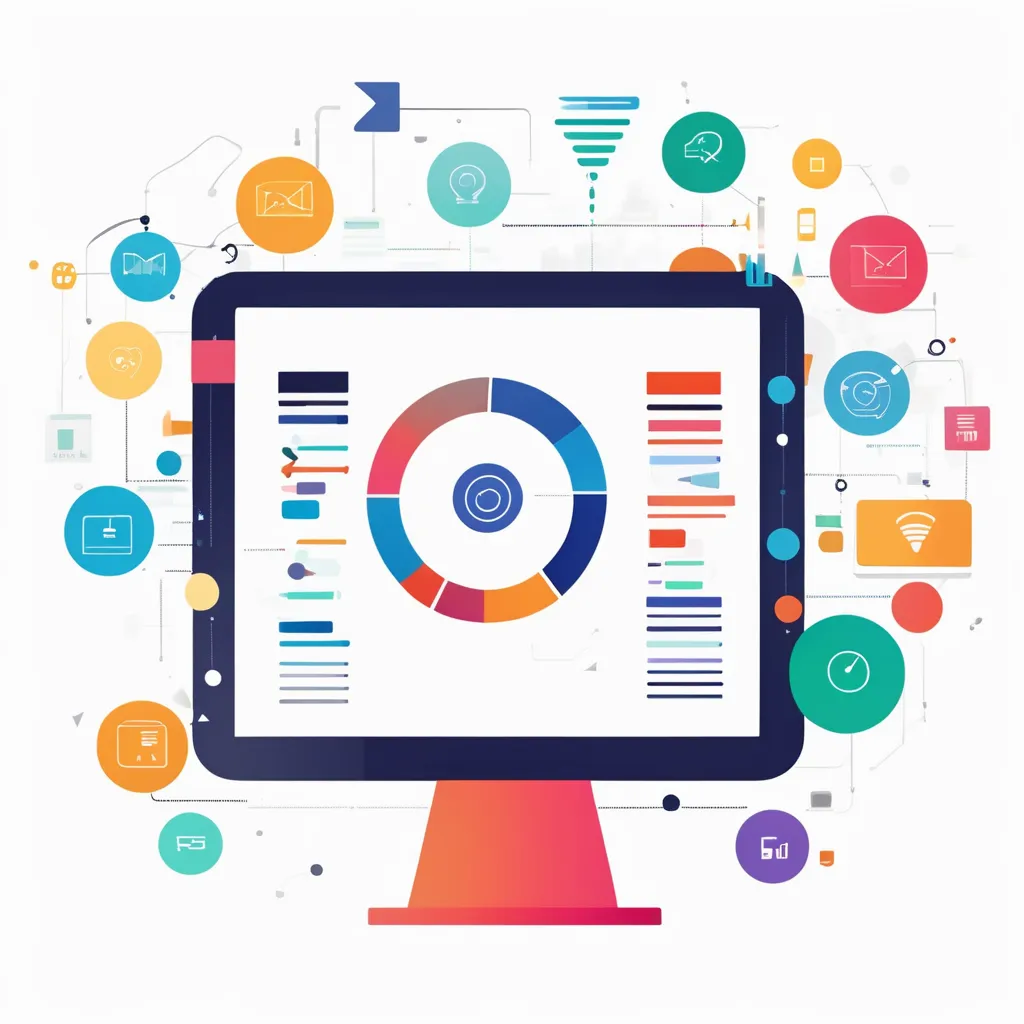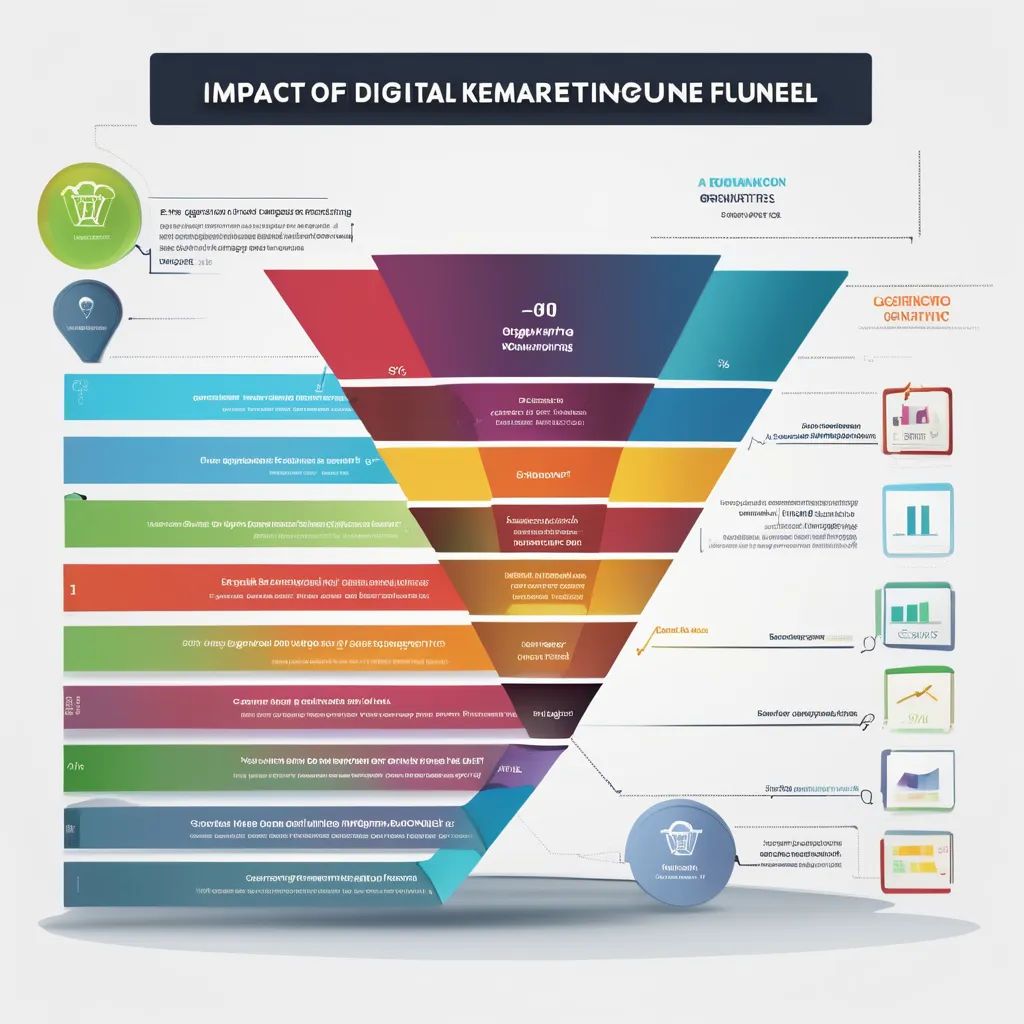Blog
How to Build a Successful Funnel in Digital Marketing for Maximum ROI

In today’s digital era, building an effective digital marketing funnel is crucial for nurturing potential leads, guiding them through their journey, and eventually converting them into loyal customers. For a 360-degree digital marketing company like Orphic Solution, a well-crafted full funnel marketing approach can significantly impact client success and maximize ROI.
This guide will take you through the steps of creating a digital marketing funnel, highlighting strategies, examples, and insights to maximize impact at each stage of the customer journey.
What is a Digital Marketing Funnel?
A digital marketing funnel represents the path potential customers take from becoming aware of your brand to making a purchase. Each stage of this funnel is crafted to support, nurture, and guide them toward conversion. By developing a clear funnel strategy, companies can effectively target specific customer needs at each stage, building trust, engagement, and loyalty.
Key Stages of a Digital Marketing Funnel
A successful funnel consists of three core stages, each requiring tailored approaches:
- Top of Funnel (TOFU): Awareness stage, where initial brand discovery happens.
- Middle of Funnel (MOFU): Consideration stage, where potential customers begin to evaluate solutions.
- Bottom of Funnel (BOFU): Conversion stage, where prospects make a purchasing decision.
Each stage has a unique goal, and implementing the right strategies at every level is key to creating a full funnel marketing approach that enhances both engagement and conversions.

1. Top of Funnel (TOFU): Creating Brand Awareness
The top of the funnel (TOFU) is all about creating awareness and drawing as many people as possible to your brand. At this stage, potential customers may not know they have a need or how your brand could meet it, so the aim is to capture interest and provide helpful, informative content.
TOFU Strategies
- Content Marketing: Utilize educational blog posts, videos, infographics, and guides that align with topics of interest to your target audience. Content should be valuable and informative, introducing concepts that naturally tie into your offerings.
- SEO Optimization: Optimize content with relevant keywords like “digital marketing funnel” and “funnel in digital marketing” to increase organic traffic. SEO is crucial for ensuring your content appears when potential customers search for related topics.
- Social Media Advertising: Leverage platforms like Facebook, Instagram, LinkedIn, and Twitter to promote engaging content, such as blog posts or explainer videos. Targeted ads can help you reach a broader audience effectively.
TOFU Content Example
Orphic Solution could create a blog titled “What is a Digital Marketing Funnel and Why Your Business Needs One” that introduces the concept of marketing funnels, discusses benefits, and subtly positions Orphic Solution as an expert in funnel-building. Such content is informative, non-salesy, and builds initial trust.

2. Middle of Funnel (MOFU): Building Consideration
At the middle of the funnel (MOFU), potential customers have become aware of your brand and may be considering your offerings along with competitors. The focus here is on nurturing leads by providing value, addressing pain points, and building trust.
MOFU Strategies
- Lead Magnets: Offer downloadable resources like eBooks, checklists, webinars, or white papers in exchange for contact information. For example, an eBook on “Effective Full Funnel Marketing for Digital Growth” provides in-depth value and captures leads.
- Email Marketing: Nurture leads through a well-crafted email sequence. Personalized, informative content in emails helps deepen engagement, keeping your brand top of mind as they continue their research.
- Retargeting Ads: Use retargeting campaigns to remind visitors who have engaged with TOFU content to revisit your site. Display ads can promote more detailed, consideration-focused content, encouraging users to learn more.
MOFU Content Example
Orphic Solution might offer a webinar titled “Step-by-Step Guide to Building a Digital Marketing Funnel” that takes a deeper dive into the mechanics of funnel marketing. This not only educates leads but positions Orphic Solution as a knowledgeable guide through complex marketing processes.

3. Bottom of Funnel (BOFU): Converting Leads into Customers
The bottom of the funnel (BOFU) is where prospects are ready to make a purchasing decision. They’ve done their research and are aware of your brand’s value but may need that final push to convert.
BOFU Strategies
- Free Trials or Product Demos: Offering a free trial, demo, or consultation helps alleviate uncertainty and gives potential customers firsthand experience with your product or service.
- Customer Testimonials and Case Studies: Social proof through case studies or testimonials builds credibility, especially when showcasing measurable results. Showcasing client success stories related to funnel marketing, for example, could encourage prospects to trust Orphic Solution’s expertise.
- Clear, Compelling CTAs: Each BOFU asset should have a straightforward, actionable call-to-action. Examples include “Request a Free Consultation,” “Download Your Funnel Marketing Guide,” or “Start Your Campaign.”
BOFU Content Example
Orphic Solution could publish a case study detailing the success of a client’s funnel transformation after using their services. Including specific metrics, such as “a 150% increase in lead conversions,” demonstrates Orphic Solution’s effectiveness in achieving ROI through a full funnel approach.
Example: Full Funnel Strategy in Action
Imagine a company offering digital marketing courses online. Here’s how they might implement a funnel strategy:
- TOFU (Awareness): Create blog posts around topics like “Introduction to Digital Marketing,” optimized with keywords like “digital marketing funnel.” Promote these posts on social media channels to drive traffic.
- MOFU (Consideration): Offer a downloadable eBook on “How to Build a Digital Marketing Funnel” as a lead magnet. Follow up with an email sequence sharing insights on different aspects of digital marketing.
- BOFU (Conversion): Conclude the sequence with a limited-time discount for the online course. Potential customers who engaged with MOFU content can be retargeted with ads promoting the offer.
By applying targeted strategies at each stage, they can attract, engage, and convert leads effectively.

Tips for Optimizing Your Digital Marketing Funnel
1. Use Data Analytics to Refine Each Stage
Regularly analyze metrics like bounce rates, engagement levels, and conversion rates at each funnel stage. This data shows where adjustments are needed to improve lead progression and maximize conversions.
2. Personalize the Journey
Incorporate personalized messaging based on customer interactions and preferences. Automation tools make it possible to personalize email content, retargeting ads, and even on-site experiences to keep content relevant and engaging.
3. Utilize Marketing Tools for Funnel Management
Using tools like Google Analytics, HubSpot, or Mailchimp can streamline funnel management, allowing you to automate, segment, and monitor interactions effectively. They help you deliver the right message at the right time, making the funnel journey seamless for customers.
4. Implement Marketing Funnel Examples and Best Practices
Successful examples from other brands can provide valuable insights into what works. Adapt best practices and test new strategies tailored to your audience for a highly effective funnel.
Conclusion: Building Your Digital Marketing Funnel with Orphic Solution
Creating a high-performing digital marketing funnel is a critical strategy for any business focused on maximizing engagement, conversions, and ultimately, ROI. By focusing on full funnel marketing, Orphic Solution ensures clients can capture leads effectively, nurture them through valuable content, and convert them with compelling offers.
Orphic Solution, with its 360-degree digital marketing expertise, can help design, implement, and optimize a funnel that aligns with your brand goals, catering to every stage of the customer journey.
Ready to boost your marketing performance with a robust funnel strategy? Contact Orphic Solution today to unlock the power of full funnel marketing for your business.
Blog
Google & Meta Ad Agency in Bhopal: Strategies That Double Conversions

A top Ad Agency in Bhopal understands that running ads isn’t enough – what truly matters is turning clicks into conversions. In 2025, where customers scroll, search, and shop online faster than ever, the debate of Google vs Meta Ads has become more relevant than ever. Using just one platform limits your reach, while smart marketers now combine both to maximize performance. That’s why at Orphic Solution, we integrate Google and Meta Ads into unified, data-driven campaigns – blending intent with engagement through automation, analytics, and creative storytelling to help Bhopal businesses double their leads and ROI.
How Google vs Meta Ads Reflect the 2025 Shift from Reach to Conversions
Digital advertising is evolving. Earlier, businesses focused on impressions; now, it’s all about performance and personalization.
Trends shaping 2025 include:
AI-driven ad optimization: Machine learning automatically improves bidding and targeting.
Cross-platform retargeting: Users see consistent brand messages across Google Search, YouTube, Facebook, and Instagram.
Privacy-first marketing: New cookie-less strategies require smarter audience segmentation.
Short-form video dominance: Reels, Shorts, and Stories now drive 65% of ad engagement.
The result? Brands that adapt early outperform their competitors – and that’s exactly what a forward-thinking Ad Agency in Bhopal like Orphic Solution delivers.
Why Combining Google and Meta Ads Works
Google and Meta reach people in different mindsets: one when they’re searching, the other when they’re scrolling.

Google Ads capture intent – users are already ready to buy or inquire.
Meta Ads create curiosity – people discover your brand through visuals and storytelling.
When combined, you cover all stages of the marketing funnel – awareness, consideration, and purchase – ensuring no potential lead slips through.
How Google Ads Turn Searches into Sales
Our Ad Agency in Bhopal uses Google Ads to target high-intent audiences who are already searching for what you offer.
What’s working in 2025:
Performance Max Campaigns: AI-powered ads that appear across Search, Display, Maps, Gmail, and YouTube simultaneously.
Local Service Ads (LSAs): Perfect for Bhopal-based businesses – you pay only for qualified leads.
Responsive Search Ads: Dynamic combinations of headlines and descriptions that adapt to user intent.
Smart Bidding: Google’s algorithm automatically adjusts bids for maximum conversions.
These innovations help you spend smarter and generate quality leads faster than traditional campaigns.
Google vs Meta – A Strategic Comparison
Meta (Facebook & Instagram) remains unbeatable for visual storytelling and community engagement.
Our campaigns focus on creating emotional connections through content that feels native, not intrusive.
Key 2025 Meta trends include:
AI-assisted creative tools: Automated caption and layout suggestions improve engagement.
Instagram Reels Ads: The fastest-growing format for awareness and quick conversions.
Click-to-WhatsApp Ads: Instant lead generation through direct conversations.
Lookalike + Custom Audiences: Meta’s strongest targeting combo for scaling sales.
With the right mix of storytelling, visuals, and data, Meta Ads warm up audiences that Google Ads can later convert.
Google vs Meta – A Strategic Comparison
| Aspect | Google Ads | Meta Ads |
| Audience Type | Intent-driven (actively searching) | Interest-based (discovering content) |
| Best Use | Lead generation, e-commerce, local visibility | Brand awareness, retargeting, engagement |
| Ad Format | Search, Display, Video, Shopping | Image, Carousel, Reels, Stories |
| Conversion Speed | Fast (direct conversions) | Gradual (relationship building) |
| Tracking Tools | Google Analytics, Tag Manager | Meta Pixel, Business Suite |
| Budget Control | CPC, Smart Bidding | Flexible CPC or CPM |
| Trends 2025 | AI Performance Max, LSAs | Short-video ads, AI-creative automation |
Google drives decisions, Meta builds desire – combine both to turn curiosity into action.
5 Proven Strategies That Double Conversions
1. AI-Based Audience Segmentation
We use machine learning tools to analyze interests, behaviors, and purchasing patterns. This ensures your ads reach users most likely to convert – not just random traffic.
2. Hyper-Localized Targeting
For Bhopal-based businesses, we target ads around specific zones like MP Nagar, Arera Colony, and Kolar Road – connecting your message with the right geography.
3. Retargeting with Relevance
Users who interacted once get re-engaged with tailored offers.
Example: Someone who visited your real-estate page sees your ad again while scrolling Instagram or watching YouTube.
4. Smart Creative Testing
We constantly A/B test ad visuals, CTAs, and headlines.
The winning variations automatically scale through automation – ensuring consistent results.
5. Conversion-Optimized Landing Pages
Each ad leads to a focused, mobile-friendly landing page.
No distractions, clear call-to-action, and trust badges that boost credibility – all designed for conversions.
Real Case Study – Local Results, National Quality
A Bhopal-based education institute partnered with us for a 45-day campaign:
Meta Ads: Brought 48,000 impressions and 300 WhatsApp inquiries.
Google Ads: Generated 190 qualified leads from targeted searches.
Result: 2× increase in conversions and a 60% drop in cost per lead.
That’s the power of combining creativity with data precision.
Why Orphic Solution Leads the Digital Ad Space
7+ years of expertise across Google, Meta, and performance marketing.
Certified professionals handling every campaign stage.
Transparent reports, real-time dashboards, and measurable growth.
3,000+ successful ad campaigns across real estate, healthcare, retail, and education.
We’re not just another Ad Agency in Bhopal – we’re your long-term partner for sustainable online growth.
Key Digital Ad Trends Businesses Should Watch
To stay ahead in 2025, Bhopal brands should focus on:
Voice Search Ads: With voice assistants booming, Google’s voice-optimized campaigns will rise.
AI Chatbot Integration: Ads linked to chatbots can capture instant leads.
UGC (User-Generated Content): Meta Ads using customer reviews or testimonials perform 35% better.
Omnichannel Retargeting: Showing consistent ads across YouTube, Instagram, and search boosts conversion by up to 50%.
By blending these trends into your campaign, you future-proof your brand against digital saturation.
Ready to Maximize Your Conversions?
Your audience is already online – it’s time your brand dominates both search results and social feeds.
Contact Orphic Solution, the most trusted Ad Agency in Bhopal, for a free campaign audit.
Our experts will craft a custom Google + Meta Ad plan that blends automation, creativity, and data to drive measurable growth.
FAQs
Q1: Why should I use both Google and Meta Ads?
Because they target different mindsets – one captures intent, the other builds trust. Combined, they deliver stronger conversions.
Q2: What’s the ideal budget for local campaigns?
You can start small; our optimization ensures every rupee delivers measurable ROI.
Q3: Do you manage creatives as well?
Yes, our in-house design team creates visuals and copy optimized for performance and brand consistency.
Q4: How soon will I see results?
Most clients notice higher engagement and conversion rates within 3-4 weeks of launch.
In today’s competitive market, success depends on smart integration, not random ad spends.
By combining Google and Meta Ads, businesses can reach intent-driven searchers and emotionally engaged audiences simultaneously.
At Orphic Solution, the leading Ad Agency in Bhopal, we leverage AI, automation, and creative storytelling to double conversions and make every click count.
Blog
Best Meta Ad Agency in Bhopal 2025 Proven Growth & Success

The digital advertising world is evolving fast, and Meta Ads (Facebook + Instagram) continue to dominate how businesses reach customers.
In Bhopal, brands are shifting from traditional marketing to performance-driven ad campaigns that bring measurable results.
That’s where choosing the best Meta Ad Agency in Bhopal becomes essential – to stay ahead of the competition, reach local audiences, and turn clicks into conversions.
Why Meta Ads Matter in 2025
In 2025, Meta’s ecosystem (Facebook, Instagram, Messenger, Threads) has become smarter, more automated, and deeply connected to user intent.
Brands now rely on AI-powered ad delivery, advanced targeting, and real-time analytics to achieve maximum ROI.
Moreover, Meta’s algorithm updates allow businesses to focus on quality engagement instead of just impressions.
Here’s why Meta Ads are a must for Bhopal businesses:
Reach 80%+ of active local users across Meta platforms.
Target based on location, interests, demographics, and behavior.
Track every click, lead, and purchase through conversion APIs.
Get scalable, measurable, and cost-effective marketing results.
Top Meta Advertising Trends in 2025
The best Meta ad companies in Bhopal are following these global trends:

AI-Driven Campaign Optimization
Meta’s built-in AI automatically adjusts bids, budgets, and audiences in real-time.
As a result, businesses waste less and gain more – especially when paired with local targeting.
Video & Reels Domination
Short-form videos continue to outperform static posts.
Agencies that create story-based Reels ads are seeing up to 3× higher engagement.
Full-Funnel Retargeting
Smart brands don’t stop at awareness – they retarget warm leads through Meta pixel + WhatsApp integration.
This ensures no potential customer slips away.
Instant Form Ads & WhatsApp Leads
Lead generation ads with WhatsApp CTA have become the most popular trend in India.
They simplify conversions and connect sales teams instantly.
Localized Creative Personalization
Using Hindi + English ad copies and Bhopal-specific visuals has proven to boost CTR by over 40%.
Localization is now a key growth tactic.
What Makes a Meta Ad Agency in Bhopal the Best Choice
Not every ad agency in Bhopal can deliver real performance.
The best ones – like Orphic Solution – focus on combining creativity with data.
1. Proven Results with Real Clients
A top Meta ad agency doesn’t guess – it tests, tracks, and reports every metric.
Orphic Solution uses advanced tracking tools and GA4 integration to measure campaign ROI precisely.
2. Experienced Creative Team
Ad visuals, videos, and copywriting decide engagement rates.
A skilled creative team ensures every ad tells a story, not just sells a product.
3. Targeting the Right Audience
Instead of broad ads, expert agencies segment audiences using location, gender, and interest filters to lower CPL.
4. Data-Driven Decisions
Each campaign is optimized weekly based on CTR, CPM, and conversion data – ensuring clients always stay profitable.
5. Transparency & Reporting
A trusted agency provides clients with monthly performance reports, ad insights, and clear ROI breakdowns.
As a leading Meta Ad Agency in Bhopal, Orphic Solution helps brands across sectors achieve 3×–5× ROI through optimized Meta ad strategies.
As a leading Meta ad company in Bhopal, Orphic Solution has helped dozens of local businesses – from cafés and real estate firms to healthcare and retail brands – grow their reach and sales.
Example:
A local restaurant achieved 5× ROI through Reels ads with location-based targeting.
A home décor brand saw 3× more leads using WhatsApp lead campaigns.
An education institute cut its ad cost by 40% with improved audience segmentation.
These results prove that with the right agency, Meta ads don’t just attract clicks – they convert them into paying customers.
Essential Tactics for 2025 Meta Ad Success
| Tactic | Description | Result |
| Smart Campaign Segmentation | Divide ads into awareness, consideration, and conversion stages | Lower CPC & higher relevance |
| Reels + Stories Ads | Visual storytelling for brand recall | 2–3× engagement boost |
| WhatsApp Click-to-Chat | Direct conversion route | Higher lead rate |
| Localized Creatives | Use city-based visuals & tone | 40% higher CTR |
| Performance Tracking | GA4 + Meta Pixel integration | Accurate ROI measurement |
Why Businesses in Bhopal Trust Orphic Solution
In a crowded market, Orphic Solution stands out as a performance marketing and Meta ad agency that focuses purely on results, not vanity metrics.
The agency combines creative storytelling, ad analytics, and automation to ensure every rupee spent turns into growth.
Whether you run a local store, a startup, or a growing brand, Orphic provides tailor-made ad strategies that scale with your goals.
Grow with the Best Meta Ad Agency in Bhopal
The future of digital marketing in Bhopal belongs to brands that master Meta Ads.
With evolving algorithms, new ad formats, and AI-driven analytics, now is the time to partner with a team that understands both creativity and conversion science.
FAQs
Q1. Why choose Orphic Solution as your Meta Ad Agency in Bhopal?
Because we focus on performance, not vanity metrics – delivering real ROI through data-driven Meta ad campaigns.
Q2. Can small businesses benefit from Meta Ads?
Yes, Meta Ads help local Bhopal businesses get leads quickly with affordable, targeted campaigns.
Q3. What results can I expect from Orphic Solution’s Meta Ads?
Clients typically see 3×–5× ROI, higher engagement, and lower lead costs within the first month.
Q4. Does Orphic Solution manage both Google and Meta Ads?
Yes, we provide complete performance marketing services including Google Ads, Meta Ads, and SEO.
Q5. How can I start working with Orphic Solution?
Visit orphicsolution.com or contact our team for a free ad strategy consultation.
Orphic Solution – the best Meta Ad Agency in Bhopal 2025 – helps you build impactful ad campaigns, generate high-quality leads, and achieve measurable growth.
Contact us today to launch your next performance campaign that truly delivers real results!
Blog
Performance Marketing Bhopal: Scale Your Business in 2025

The future of digital growth lies in Performance Marketing Bhopal – where every click, lead, and sale is tracked, measured, and optimized. In 2025, local businesses aren’t just advertising; they’re scaling smarter through data-driven campaigns that deliver real ROI.
At Orphic Solution, we combine creative storytelling, automation, and analytics to help brands grow faster with measurable performance across Google, Meta, and other paid media platforms.

Grow beyond visibility – grow with performance.
Why Performance Marketing Bhopal Is the Key to Growth
Marketing has changed. It’s no longer about impressions-it’s about conversions. Businesses in Bhopal are shifting toward performance-driven advertising because it ensures that every rupee spent delivers measurable results.
2025 marketing shifts driving this trend:
AI bidding automation for efficient ad spend.
Cross-channel attribution to track leads from search to social.
Personalized remarketing powered by behavioral data.
Conversion-based optimization ensures better ROAS (Return on Ad Spend).
Companies investing in Performance Marketing Bhopal are seeing up to 60 % faster growth than those using traditional marketing alone.
What Makes Orphic Solution the Best in Performance Marketing Bhopal
As a trusted name in the city, Orphic Solution goes beyond generic campaigns-we create growth engines built on insight and innovation.
1. Advanced PPC Marketing Services
Our PPC marketing services focus on targeting high-intent customers through Google Search, Display, and YouTube ads. Each campaign is designed to bring qualified leads, not random clicks.
2. Full-Funnel Paid Media Services
We manage every step-from ad creation to optimization-so your business stays consistent across all platforms. Our Paid Media Company approach ensures every ad contributes directly to your sales funnel.
3. Social Media Services in Bhopal
Your audience is already online-our social media services make sure they find you. We build engagement-focused campaigns across Instagram, Facebook, and LinkedIn that turn attention into action.
4. Integration with Google and Meta
As a Google and Meta Ad Agency, we blend both ecosystems for maximum results:
Google captures intent through search.
Meta builds interest with storytelling and retargeting.
5. Transparent Performance Dashboard
Every client gets access to real-time dashboards showing metrics like CTR, CPL, and ROI-because true performance marketing means total transparency.
Google + Meta – The Power of Dual Strategy
Combining Google and Meta Ads helps Bhopal businesses dominate both search results and social feeds.
| Platform | Core Strength | Growth Advantage |
| Google Ads | Targets active searchers | Drives immediate, high-quality leads |
| Meta Ads | Builds emotional connections | Strengthens brand recall & loyalty |
| Together | Full customer journey | Boosts conversions up to 2× |
Google delivers precision, Meta delivers presence – together they build unstoppable brand performance.
How Our Paid Media Agency in Bhopal Drives Growth
1. Smarter Audience Targeting
We use AI-based segmentation to reach the right users at the right moment, maximizing ad relevance and engagement.
2. A/B Testing That Never Stops
From creative design to CTA placement, every element is tested for continuous improvement and better conversion rates.
3. Dynamic Budget Shifting
Budgets automatically adjust between Google and Meta based on daily performance insights, ensuring zero waste and full ROI.
4. Retargeting That Converts
Our Meta Ad Company re-engages potential customers who visited your site but didn’t take action-building familiarity that leads to sales.
5. Landing Pages That Sell
All ads lead to optimized landing pages with trust signals, mobile speed, and clear CTAs. Because good ads need great destinations.
Local Growth Story – Real Results, Real Impact
A Bhopal-based interior design firm partnered with Orphic Solution for a 45-day performance campaign:
Google Ads: 180 high-intent inquiries.
Meta Ads: 420 message leads through reels and story campaigns.
Outcome: Conversions doubled, CPL reduced by 35 %, and brand visibility skyrocketed across Bhopal.
Smart strategy + creative content = measurable growth.
Why Brands Choose Orphic Solution
7 + years of experience in Performance Marketing Bhopal.
3,000 + campaigns executed across industries.
Expertise in PPC, Meta Ads, SEO, and Paid Media Services.
Transparent, ROI-focused reporting.
Dedicated strategists who treat your business like their own.
We’re not just another ad agency – we’re your growth partners committed to measurable success.
2025 Performance Marketing Trends to Watch
Stay ahead of your competitors with emerging digital innovations:
AI-optimized bidding for smarter campaign scaling.
Voice-search advertising on Google devices.
Click-to-Chat funnels connecting ads directly to WhatsApp.
Omnichannel remarketing across YouTube, Instagram, and Search.
First-party data strategies in a privacy-driven world.
Brands adopting these methods are witnessing 50 % higher engagement and consistent month-on-month growth.
Your Growth Starts Here
Your audience is online right now – searching, scrolling, and deciding. Are they finding you or your competitors?
Contact Orphic Solution, the most trusted name in Performance Marketing Bhopal, and get a free campaign audit today.
We’ll design a full-funnel strategy using Paid Media Services, PPC marketing, and Meta Ads that deliver measurable business expansion.
Every click should count – let’s make yours convert.
FAQs
Q1. Why choose performance marketing?
Because it’s measurable, scalable, and guarantees ROI – you pay only for real results.
Q2. Which platforms deliver the best ROI?
A mix of Google and Meta Ads ensures consistent visibility, intent capture, and lead conversion.
Q3. How soon will I see results?
Most clients experience lead growth and conversion uplift within 20-30 days of launch.
Q4. Can small businesses benefit too?
Absolutely. Our tailored Paid Media Services in Bhopal make it affordable for startups and SMEs to compete effectively.
In a city full of growing businesses, standing out takes strategy, not luck. With Performance Marketing Bhopal, you turn ad spend into measurable growth, blending creativity with data precision.
At Orphic Solution, we don’t just run ads – we build scalable systems that grow brands month after month.
Join hundreds of Bhopal businesses already achieving success through smarter, data-driven marketing.






